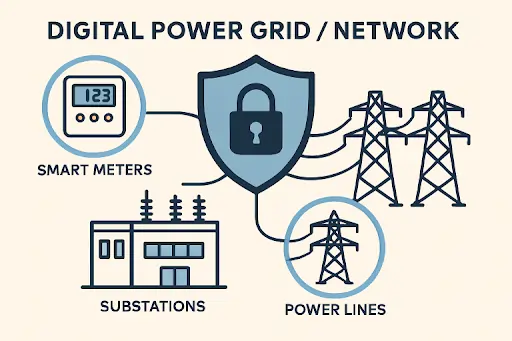Key Takeaways
- Smart grids boost efficiency, reliability, and energy management.
- Cybersecurity risks are growing, especially in legacy systems and smart devices.
- Compliance, advanced technologies, and collaboration strengthen defenses.
- Balancing innovation with privacy and continuous adaptation is essential.
The Digital Power Grid Revolution
The energy industry is undergoing a historic transformation as digital technologies reshape traditional electrical grids. Modern smart grids integrate advanced sensors, automated controls, and real-time data analytics, delivering more reliable, efficient, and sustainable energy distribution. These interconnected networks provide substantial benefits—from lower energy costs and outage detection to more flexible demand management. However, as the digital power grid revolution accelerates, it introduces complex cybersecurity demands that require coordinated and proactive risk management. To strengthen your grid’s compliance and safeguard against evolving cyber threats, you can learn more about professional approaches to smart grid security.
Digitalization of critical infrastructure has magnified the grid’s exposure to cyberattacks. As power systems move away from isolated analog controls, attackers find more entry points through remote access technologies, distributed energy resources, and cloud-based management tools.
Main Cybersecurity Risks Facing Smart Grids
Integrating information technology (IT) and operational technology (OT) within the smart grid widens the attack surface. Among the most persistent threats are phishing schemes targeting personnel, often as a gateway for installing malware or ransomware on critical systems. Malware can be embedded through seemingly harmless attachments or links, while ransomware can lock down control centers, demand payment, and halt grid operations. Distributed Denial of Service (DDoS) attacks, in which networks are flooded with illegitimate traffic, can interrupt essential grid communications. Critical infrastructure experts warn that substation automation, remote terminal units, and SCADA (Supervisory Control and Data Acquisition) systems are prime targets for such attacks since they often operate with minimal segmentation and outdated protections.
Unique Vulnerabilities in the Smart Grid Ecosystem
The smart grid ecosystem brings together legacy infrastructure, modern IoT-enabled devices, and third-party vendors, collectively expanding the potential avenues for attack. Older control systems, never intended for internet connectivity, are often ill-equipped to withstand today’s sophisticated cyber threats. By contrast, newer “smart” devices such as meters, sensors, and controllers are frequently shipped to market with basic security features, making them easy entry points for cybercriminals.
A notable case involved a major European utility whose digital meters were remotely compromised, enabling the attackers to disrupt billing operations and attempt power diversion.
Critical Regulatory and Compliance Challenges
Evolving security requirements from regulators put mounting pressure on grid owners and operators to adopt best-in-class cybersecurity practices. In the U.S., directives from the Federal Energy Regulatory Commission (FERC) and North American Electric Reliability Corporation (NERC) define minimum standards for critical infrastructure cybersecurity, mandating risk assessments, reporting obligations, and incident response planning. Internationally, frameworks such as the EU’s Network and Information Security (NIS) Directive push operators toward harmonized protections.
Technology Solutions: Detection, Protection, and Response
Technology innovation is defining the next generation of smart grid security. Artificial intelligence (AI) and machine learning tools are revolutionizing threat detection, analyzing vast amounts of network data to uncover abnormal activity, pinpoint potential intrusions, and prioritize response. Automated incident management accelerates threat response, minimizing downtime during cyber events.
Measures like network segmentation, which divides the smart grid’s infrastructure into isolated segments, limit cyber attackers’ movement. Zero-trust security frameworks, which require continuous verification of devices and users, are rising as gold standards in operational security. These technical advances provide a foundation, but their efficacy is maximized when paired with rigorous cybersecurity training and ongoing risk assessments across the enterprise.
The Role of Collaboration Across the Industry
No organization can secure the grid in isolation. Security is a shared responsibility spanning public agencies, industry standards bodies, private utilities, and technology vendors. Organizations such as the National Institute of Standards and Technology (NIST) and the National Institute of Standards and Technology actively develop and update sector standards, circulate threat intelligence, and coordinate rapid incident response when threats emerge.
Cross-sector partnerships provide a vital channel for sharing lessons learned, validating new technologies, and conducting joint defense exercises. Cybersecurity alliances and public-private information-sharing bodies boost collective resilience, ensuring that knowledge gaps are quickly closed and new countermeasures are distributed throughout the energy sector.
Balancing Innovation with Security and Privacy
Rapid innovation in the smart grid sector—such as the rollout of smart meters and adaptive energy management—raises important questions about data privacy and consumer trust. The granular data collected from households and businesses is invaluable for optimizing energy flows and crafting new services, but also presents risks if accessed by unauthorized parties.
Utilities must navigate a delicate balance: integrating new features while implementing strong privacy safeguards, consent protocols, and encryption. Educating consumers about their rights and the uses of their data fosters confidence, while regular risk reviews allow utilities to stay ahead of emerging threats.
Future-Proofing the Smart Grid
As the smart grid ecosystem evolves, so do the tools for defending it. Emerging trends such as quantum-proof cryptography, digital twins, and predictive analytics are expected to play critical roles in future-proofing power infrastructure. Investment in skilled cybersecurity personnel, as well as adopting adaptive, cloud-based defense frameworks, remains crucial. Stakeholders can prepare today by integrating these technologies, enhancing monitoring practices, and maintaining ongoing engagement with sector-wide security forums.
Energy resilience will depend on innovation, vigilance, and cooperation. By prioritizing modernization and unwavering cybersecurity, the digital power grid can continue delivering reliable, sustainable energy for all.
Read more: Can You Run iOS Apps on Android? Here’s What You Need to Know – Croudmomentum.com
$1 Deposit Casino: The Ultimate Low-Stakes Gateway to Online Gambling – Croudmomentum.com
Crowdfunding 101: What Are the Different Types of Crowdfunding? – Croudmomentum.com








